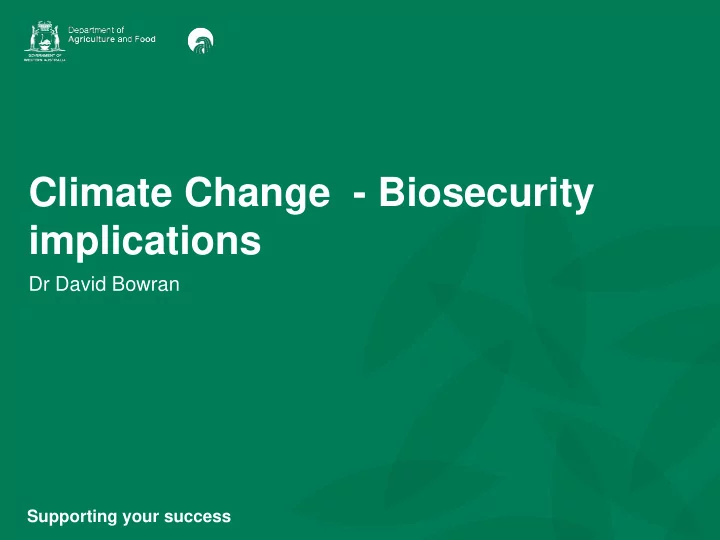

Climate Change - Biosecurity implications Dr David Bowran Supporting your success
Current climate change in WA Last decade has seen lowest on record rainfall for winter months over the SWWA in some years, record monthly temperature highs in summer and some winter months. Surface air pressure changes started in the 1970’s and have been coincident with the reduction in rainfall With climate considered to be the average for the last 30 years, the current trends of annual and seasonal rainfall or temperatures in the last 14 years have become more pronounced especially in the south west Warmer oceans are being seen to the west of Perth, and the Indian Ocean is warming more consistently than any other major ocean Global modelling at the regional scale for WA and Australia suggests that this trend may intensify from 2020 to 2060 as the storm tracks move further south and the Hadley cell expands. Meanwhile the north has been getting wetter! And warmer air holds more water, which may intensify rainfall events – fewer but heavier? Supporting your success
Changes in water cycle over next century IPCC 5, 2014. Supporting your success
Synoptic patterns with major influence on SWWA rainfall Bates et al., 2007 Supporting your success
Projected rainfall changes for end of century IOCI3 Technical Report, 2012 Supporting your success
Annual rainfall change last 20-60 years Supporting your success
Temperature Trends Supporting your success
SST anomaly at 80-110E, 25-40S Bureau of Meteorology Supporting your success
Current temperature analysis for 2014 Supporting your success
CC and biosecurity Globally assessments of the implications of climate change on biosecurity and the changes that might be experienced in natural or managed ecosystems is ramping up Some countries eg USA and some individual regions eg South Australia have begun the task of identifying when, where and how threats might originate or change as climate changes, and what to do about them The literature highlights the importance of numerous interactions, some of which are positive for biosecurity, some neutral and some negative. In many cases CO2 increases, ocean acidity, intensification of wind and rainfall extremes are highlighted as drivers. Fire is a significant factor in many models of change in natural ecosystems as humidity drops and temperatures increase. Supporting your success
CC and biosecurity Supporting your success J. Luck, I.D. Campbell, R. Magarey, S. Isard, J-P. Aurambout and K. Finlay, 2014
Entry - An Invaded Ecosystem Katsanevakis et al , 2014 Alien-to-native ratio of fish and invertebrates richness in the coastal Supporting your success areas of the Mediterranean Sea
Future CC in the Mediterranean Past changes in seawater temperature and future projections in the Mediterranean Sea. Coll M, Piroddi C, Steenbeek J, Kaschner K, et al. (2010) The Biodiversity of the Mediterranean Sea: Estimates, Patterns, and Threats. Supporting your success PLoS ONE 5(8): e11842. doi:10.1371/journal.pone.0011842
Spread - Extreme events Supporting your success
Establishment projections – CLIMEX / EI analysis Climate change and invasive plants in South Australia Darren J. Kriticos, Neville D. Crossman, Noboru Ota and John K. Scott (2010). Eco-climatic Index for Bridal creeper range change Supporting your success
Consequence - Spread of blue tongue Bluetongue Disease, which started in Africa, has spread in the last decade to Europe and killed more than 1.5 million sheep there. Bluetongue is transmitted by a tiny biting midge, Cullicoides immitus, similar to the way that malaria is spread by mosquitoes. Sheep with swollen, bright blue tongues: it is a surreal sight only recently spotted in Germany. Climate change is not only speeding up the rates of reproduction, development, survival and biting of blood-feeding pests, but is also shortening the parasite development time inside these disease- transmitters, and increasing the range of the midge. Supporting your success
Conclusions • There remains an increasing need to have better data/science on how species respond to climate change eg phenology with introduced species flowering earlier than natives, fish spawning in areas outside their normal range • The likely pervasiveness and complexity of vegetation/animal disequilibrium under climate change is a major challenge for forecasting ecological dynamics and also constitutes a major challenge for future nature conservation. • Alien species may be successful invaders because they are more phenologically flexible than native species and track climate change more closely. Either phenotypic plasticity or genetically based local adaptation may contribute to phenological flexibility. • Integrative approaches that combine elements of the above with climate change and biosecurity analysis may be an area for consideration for hazard identification and mitigation of current and future biosecurity threats. Supporting your success
An apolitical view of the weather Supporting your success
Thank you Supporting your success
Recommend
More recommend